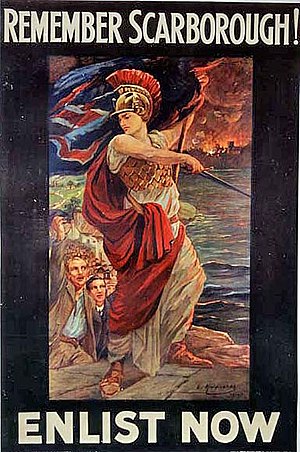Raid on Scarborough
| Raid on Scarborough, Hartlepool and Whitby | |||||||
|---|---|---|---|---|---|---|---|
| Part of the First World War | |||||||
 British propaganda poster following the raid |
|||||||
|
|||||||
| Belligerents | |||||||
|
|
|
||||||
| Commanders and leaders | |||||||
| Vc. Adl. George Warrender Vc. Adl. David Beatty |
Franz Hipper Adl. Friedrich von Ingenohl |
||||||
| Strength | |||||||
| 6 dreadnought battleships 4 battlecruisers 4 armoured cruisers 4 light cruisers 7 destroyers |
4 battlecruisers 1 armoured cruiser 4 light cruisers 18 destroyers High Seas Fleet |
||||||
| Casualties and losses | |||||||
| 137 fatalities 592 casualties 1 damaged cruiser 3 damaged destroyers |
3 damaged cruisers | ||||||
The Raid on Scarborough, Hartlepool and Whitby on 16 December 1914, was an attack by the Imperial German Navy on the British seaport towns of Scarborough, Hartlepool, West Hartlepool and Whitby. The attack resulted in 137 fatalities and 592 casualties, many of whom were civilians. The attack resulted in public outrage towards the German navy for an attack against civilians and against the Royal Navy for its failure to prevent the raid.
The German Navy had been seeking opportunities to draw out small sections of the British fleet which it could trap and destroy. Shortly before, a raid on Yarmouth had produced few results but demonstrated the potential for fast raiding into British waters. On 16 November, Rear Admiral Franz Hipper—commander of the German battlecruiser squadron—persuaded his superior, Admiral Friedrich von Ingenohl, to ask the Kaiser's permission for a raid. U-17 was sent to investigate the area near Scarborough and Hartlepool for coastal defences. The submarine reported little onshore defence, no mines within 12 mi (10 nmi; 19 km) of the shore and a steady stream of shipping. It was also believed that two British battlecruisers—which would be the fast ships sent out first to investigate any attack—had been despatched to South America, where they had taken part in the Battle of the Falkland Islands.
Hipper's force included the battlecruisers SMS Seydlitz, Von der Tann, Moltke and Derfflinger, the slightly smaller armoured cruiser SMS Blücher, four light cruisers SMS Strassburg, Graudenz, Kolberg and Stralsund and 18 destroyers. Ingenohl took the 85 ships of the German High Seas Fleet to a position just east of the Dogger Bank, where they could assist if Hipper's ships came under attack from larger forces, but were still safely close to Germany as standing orders from the Kaiser instructed.
...
Wikipedia
